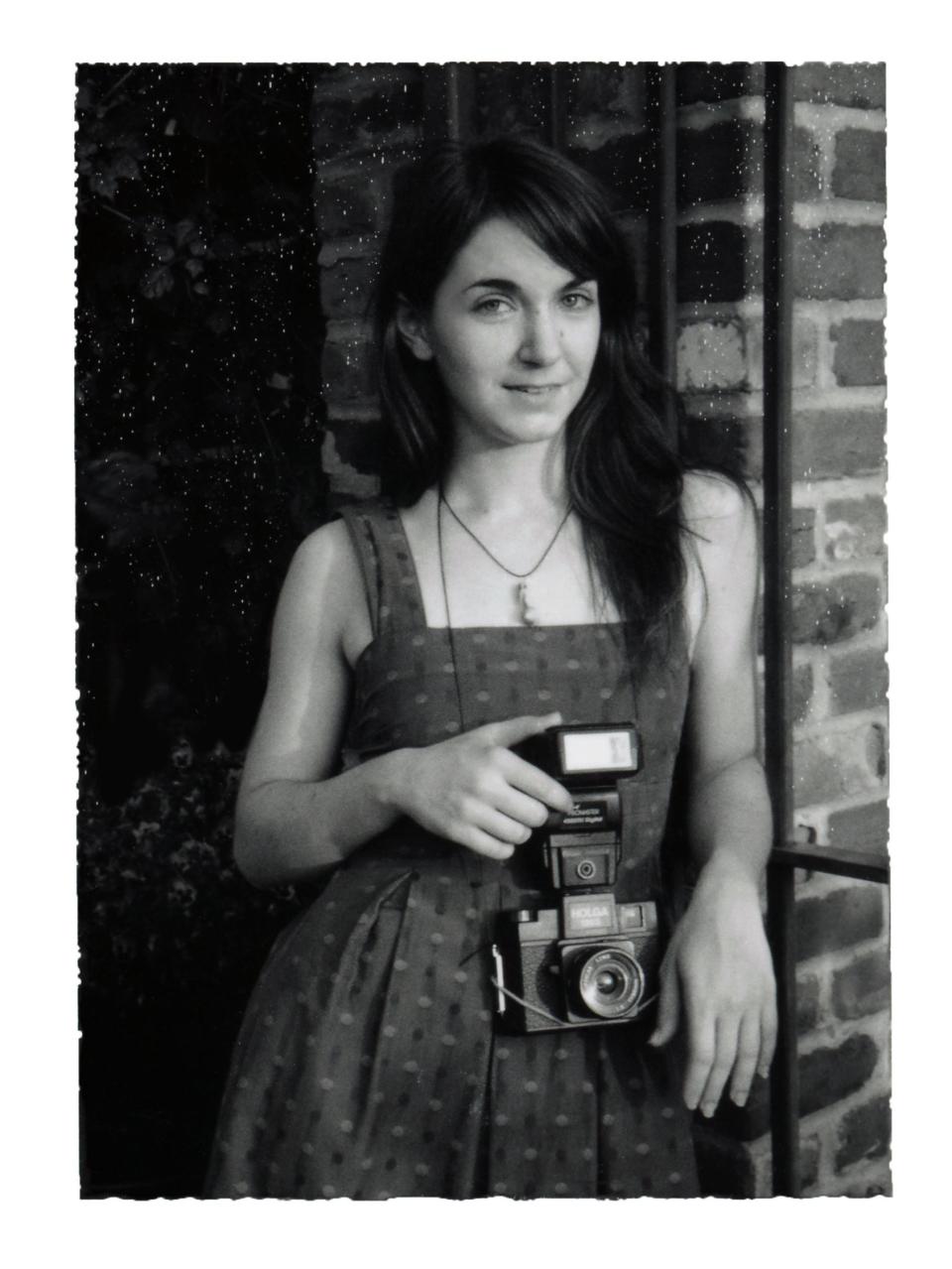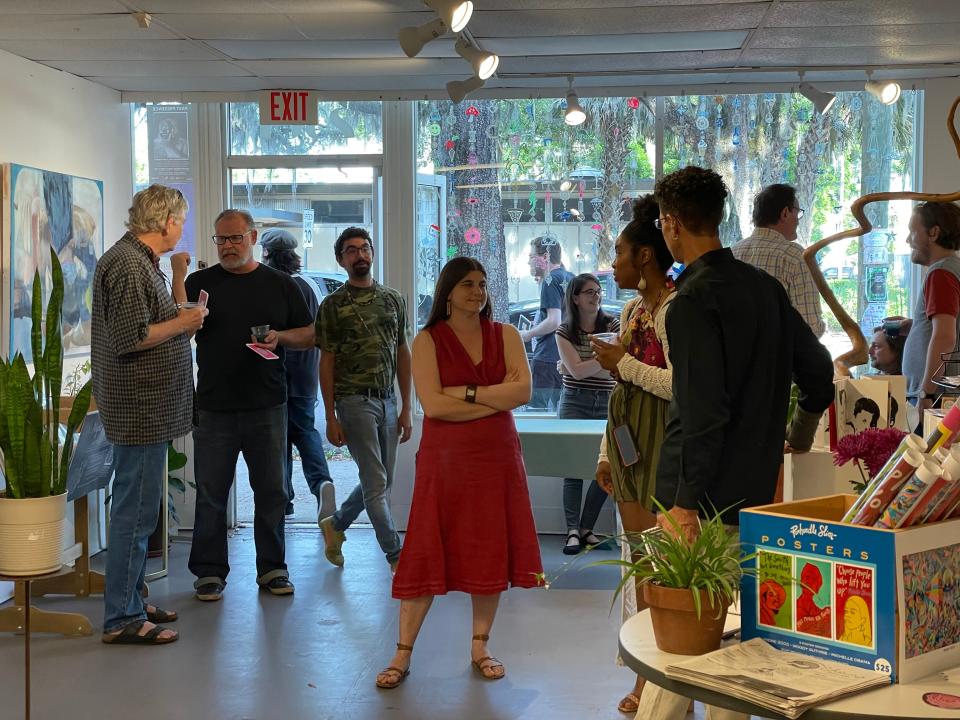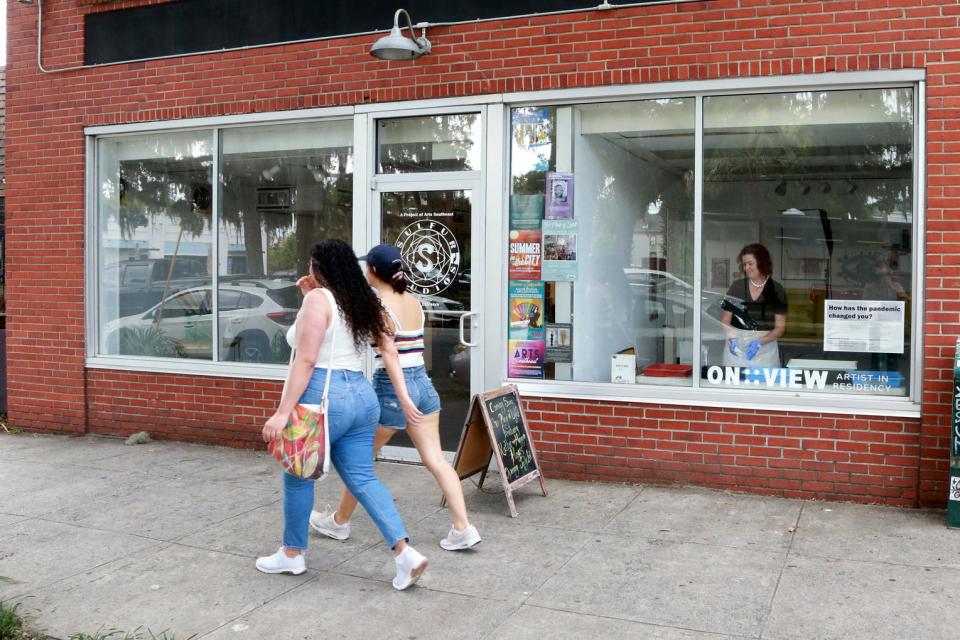ARTS Southeast's Emily Earl has a vision for Savannah as an arts destination
- Oops!Something went wrong.Please try again later.
Savannah-native Emily Earl, photographer, owner of Prismatic Prints, co-founder of Sulfur Studios, and executive director of the nonprofit ARTS Southeast, is the daughter of artists Susan and John Earl. Building on her parents’ legacy and a childhood of creativity, she embraces the mission of making Savannah a destination for art and culture in the Southeast. We discuss her upbringing, why she felt called to build an organization to support established and emerging artists, and how next month kicks off a major initiative to recruit more ARTS Southeast supporters.
Beth Logan: Tell me about your parents.
Emily Earl: "Both my parents were photographers, though my mom has become better known as a writer more recently. They met on Ossabaw Island. She was there for the Ossabaw Island Project. My dad had been a jazz musician in the '50s and '60s and then became a nature photographer. He was working on his book "John Muir’s Longest Walk," following the naturalist’s 1,000-mile walk from Indiana to the Gulf and was photographing on the barrier islands in the '70s. He was on Ossabaw when they were doing the Ossabaw Island Project and the Genesis Project [a unique interdisciplinary fellowship program established by Sandy and Clifford West, to be the subject of a show at Telfair Museums in 2025].
Dad was good friends with Sandy West, the owner of Ossabaw, and my mom was there on a residency; she was a large format black-and-white portrait photographer. Really beautiful work. So, my parents met there in 1977, fell in love, and then very soon after got married. They moved to Atlanta for a while, to New York briefly, and then ended up back in Savannah. Trying to meet people here, they put on a duo photography show in the space that is now ShopSCAD. Paula [Paula Wallace, president of the Savannah College of Art and Design] and her first husband walked in, met them, told them they were starting an art college, and hired them to be photography professors.

My mom only worked there briefly (she is an amazing photographer and darkroom printer) before returning to health care, but my dad taught in the photo department for 25 years, and later in his career, building on his memories and experiences as a jazz musician, he taught classes on the history of jazz."
Beth Logan: Tell me about your childhood and how it shaped your becoming a photographer.
Emily Earl: "My parents married in ’78 and I was born in ’85. All my family vacations as a kid revolved around hiking and taking pictures. When I was 4, they started buying me disposable cameras and finally a real one. My mom gave up her darkroom when I was about 5, so I didn’t really learn about all that until I went to the Savannah Arts Academy and took a photo class with Lyn Bonham, who then went on to teach at SCAD. She was an amazing teacher to have in high school…
One of the assignments she gave us (which, in retrospect may not have been the safest idea!) was to “take a roll of film home over the weekend, and every frame on the roll has to be of a different stranger you meet.” I was the shyest person in the world then. It was a terrifying assignment, but I feel like it informed my photography ideas ever since and got me interested in street photography. Just to get out there and meet and document total strangers."
Beth: Was it a foregone conclusion that you would attend SCAD?
Emily: "Yes – we’d talked about it since I was little. There was a moment when I wanted to be a fashion designer, but I eventually went there certain I wanted to study photography. SCAD was great, and I used that darkroom as much as I could. I had visions of working for a bad-ass photographer as their photo assistant after graduation but that was right when digital photography was coming in. So, I took odd jobs here. I worked at Savannah’s Worldwide Camera’s lab since I was 15 until the store closed in 2016. My printer and all my equipment [for her own business Prismatic Prints] were from there. I learned a lot working at Worldwide and that was how I was able to afford to create so much of my personal work."
Beth: Describe your work.
Emily: "I was doing a lot of medium-format color portraits in my early 20s. You didn’t have to do a senior show back then [she graduated with a BFA in Photography in 2007], but several friends and I did a little show at the Desoto Row Gallery when that was still a thing. I was pretty burned out, and then my father died in 2008. That was very rough, and I didn’t really do anything much for a while.
But in 2011, I got this Polaroid ProPack camera and started getting all these good images. I started taking my photography a little more seriously, and then it evolved into a more fully conscious project where I was going out most nights to shoot. From 2012 to 2020 I was obsessed with going out to shoot. To get anything good you really have to be out there for six hours, at least from midnight to 4:00am.
I did a little show at a friend’s gallery on East Broad early in the project. I learned a lot by putting it out there. Then Erin Dunn and Rachel Reese from the Telfair made studio visits and that led to an #art912 solo show at the Jepson."
Earl’s highly acclaimed, gritty, black-and-white Late Night Polaroids were shown at the Jepson from 2020-2021; at the HIGH Museum, APG Gallery and MOCA-GA in Atlanta; the Klompching Gallery in New York; Candela Gallery in Richmond, Virginia; the Rencontres d’Arles international photography festival in Arles, France; and was featured by the New Yorker and Polaroid. Earl published a monograph of 75 images from the series with a foreword by Dunn, Telfair Museums’ Curator of Modern and Contemporary Art, and an introduction by one of her idols, Judy Linn, most renowned for her images of Patti Smith and Robert Mapplethorpe.

Beth: How did Sulfur Studios come about?
Emily: "It was 2014, and I was working at the [Sentient] Bean at night with A. J. and Jennifer [SCAD graduates A. J. Perez and Jennifer Moss]. Jennifer had just graduated from SCAD with her MFA and was looking for studio space. She was complaining about the lack of studios and the Bean’s co-owner overheard and said, “You know I have this building on 39th and Bull that’s been sitting empty for a year. I can’t get anyone to rent it. There’s a bunch of rooms in there, just pick a room and use it for free until somebody rents it.” So, she did, and then she kept coming to work and telling me about it: 'I just really think other artists should be in these other rooms.' The three of us sat down and really thought it through, and the owner gave us the downstairs for six months for free. He said, 'If you guys can make it happen, then we’ll sign a lease.'
It had been the Homeless Authority and all the rooms had been little offices; the space in the middle [now the main gallery] was their conference room and it was dark purple. There was brown carpet everywhere. We invited artists to do pop-up shows in the little rooms at an open house so people could understand what it could be. We had a band play in the big room and there was a lot of excitement. We got people to move into the studios. It took us several months to paint the gallery, get the lighting and book the first shows.
Every Friday for a while we were doing receptions and a lot of music shows, and then we started doing First Fridays. It consumed everything. I just remember I’d go home and pass out. We really pushed hard. There were no rules. Any idea we had, we could try it. No one had done it before. After the first year we took over the upstairs too, and we worked with the owner on a payment plan to pay off the construction costs of building-out more studio spaces. Now we always have a wait list of 10 people for studios.
Jennifer was definitely the leader for a long time. She was highly organized and was able to think ahead. She knew when the SCAD kids needed to show their work and was doing local and national call-for-entry shows for the other months. It was a lot of work. Shows were only for one or two weeks, and then you had to take it all down and reset the gallery for the next show. Last year was the first time shows were a month, and this year they are up for two months."
Odd jobs make good art: How some Savannah artists pay the bills to fuel their creativity
Today, Sulfur Studios is home to 26 artist studios offered at under-market value, while First Fridays in Starland and Sulfur Street Fairs have become the must-see monthly community event celebrating the district’s arts scene and locally owned businesses. The Supporter Gallery highlights juried work from supporter members, while the main gallery has shown work from such prestigious artists as Lisa D. Watson, Betsy Cain, Jose Ray, Jerome Meadows and Ben Tollefson.
On display through June 24 is “Children of the Sun: In Orbit,” work by Jennifer Mack-Watkins, who recently showed at New York’s Metropolitan Museum of Art and has just published a book with Penguin Random House.
Art of Mugging: SIP: A Ceramics Show sells ceramics for charity
Beth: When did Jon Witzky [Emily's partner and current director of exhibitions] get involved?
Emily: "Jon came to Savannah in 2018 to teach at Georgia Southern and was looking for studio space for his personal work. When he moved into the studio across from mine, we got to know each other and he kept offering to help, but I felt bad involving him when it was so much work and we couldn’t pay him. But then Jennifer took a step back [she teaches fibers at a local university], and Jon took over her duties. From the very beginning of him coming into the group, he has had a shared vision for where our organization needs to go and has really taken the exhibitions and residency programming to the next level.
I’m super proud of our new IMPACT Magazine. For the last couple of years, the lack of a local art publication has been a conversation we’ve heard and had with all types of people in Savannah. Art is normally an aside in local journalism, but there is so much art happening! So many artists and creative people. So, you know the way you complain about something, but you don’t really realize that you’re going to be the one to do something about it? Jon’s always wanted to do an arts magazine, and I love print. One of the first times we ever hung out, we sat on the couch in my studio and flipped through an entire Art Forum, and it’s weird to think that just two years later we’re making our own art magazine."

Beth: How did Sulfur Studios grow?
Emily: "Well, it all started very DIY. I had never curated a show before, but after you do it so many times, you figure out along the way what works and what is feasible. And then you start to dream a little bigger. With all the artists in the studios, you get into these conversations… They really want to have others to bounce ideas off, be part of a community and collaborate. We always knew we wanted to offer a residency program and give a studio to someone for free. And we always wanted an apartment so we could bring people from out of town. With subsidies from Carmela Aliffi and her late wife Jane Fishman, we were able to make that happen."
Today, the international ON:VIEW Residency shines a global spotlight on Savannah by hosting more than 40 artists from Savannah and places as diverse as Japan, England, Germany, Texas, and Oregon. Community involvement and education of grade school through college level students is an integral part of the Residency program’s outreach.
Beth: How did ARTS Southeast come about?
Emily: "A couple of years into doing Sulfur we knew it should be a nonprofit. We wanted to be able to do bigger shows, to give artists stipends, do publications, to bring people from across the country or across the world. We needed to be a nonprofit to get grants and donations to do that. There was no way to sell enough art to come up with that money! But obviously starting a nonprofit is very intimidating and takes a lot of work and research, and we were in reactive mode doing show after show and event after event.
It was not until the pandemic (during which the landlord was, again, incredibly generous and forgiving) that life slowed down enough for Moss, Perez, Witzky, and Earl to think things through, make a research trip to meet the Executive Director of Charleston’s nonprofit Redux Contemporary Art Center, as well as places like Mint and Atlanta Contemporary in Atlanta, and finally file the necessary paperwork to restructure as a 501c3 nonprofit.
We built the Board of Directors, built the supporter program, and started acting like a nonprofit in 2021, but we didn’t get the formal designation to become ARTS Southeast until early 2022. It’s been an interesting journey because I feel like now this organization is bigger than us. This city has been bubbling and now it’s boiling! There is so much energy, momentum, and attention."
Beth: What does the future hold for ARTS Southeast?
Emily: "Any real city is going to have an arts nonprofit where the community comes to share ideas, to learn, meet each other. That’s what we are, but we want to be more, to be bigger. ARTS Southeast is something that Savannah needs.
SCAD is here but is very much its own universe. Savannah is an arts destination and in the next five, 10 years it will be even more so. I don’t think there’s a cohesive vision for that yet, but the art that’s being made here is on par with what’s happening in Atlanta and other southeastern cities, and we can shine a light on that. We want to give opportunities to emerging artists to put themselves out there. Savannah is a remarkably interesting place, and we want to help showcase all the diverse types of people doing unique things here.
Artists are making art because it’s their passion, because it’s a skill, because it has value. For example, I hope we can start a program to help artists make public art here. Who can expect them to understand all the paperwork?! But if we can understand, and have a relationship with the City, then we can support them. ARTS Southeast can be a resource both for artists and for helping the City understand what artwork is appropriate in which locations. There should be artists’ grants in Savannah. We want to be part of a bigger framework for support both from the City and from the Chamber.
Savannah can be an art hub in this region. It’s primed for that, and we can help build and guide that. And anyone can be part of our vision by joining ARTS Southeast as a supporter."
Artist-in-Residence: Nancey B. Price is 'making space' with her identity workshop for ARTS Southeast
The upcoming First Friday and Sulfur Street Fair on June 2 marks the launch of an inaugural $60,000 community-based fundraiser. The fundraising efforts are co-chaired by octogenarian artist advocate Charlie Ellis and by young artist entrepreneur Amelia Jamerson, and and a local philanthropic couple have already stepped up with a generous $5,000 leadership gift.
For full information on supporter levels, current exhibitions, the ON:View Residency program, IMPACT Arts and Culture Magazine, First Fridays, studio space, community partnerships and educational outreach, go to ARTSSoutheast.org and visit them at 2301 Bull St. Executive Director Emily Earl can be reached at info@artssoutheast.org and donations can be made at ARTSSoutheast.org/donate.
This article originally appeared on Savannah Morning News: ARTS Southeast's Emily Earl has vision of Savannah as arts destination

